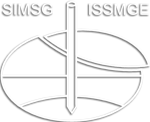Effect of contact resistivity and AC frequency on the resistivity of clays under different contamination states
Effect of contact resistivity and AC frequency on the resistivity of clays under different contamination states
Resistivity surveys have been widely used to study the transport behavior of contaminants in soil, while its accuracy is stated will be influenced by the testing methods including the two-electrode and the four-electrode method. In this paper, the Miller soil box test was performed to investigate this subject on clays with different contamination states. Firstly, two factors of the contact resistivity and AC frequency, which may affect the accuracy of the two-electrode method on the soil resistivity were studied and quantified. The results show that the presence of the contact resistivity causes the tested soil resistivity to be larger than its true value, and the contact resistivity itself decreases as a power function with the increase of soil volumetric water content, due to the increase of the contact degree between the electrode and the soil specimen. The increase of AC frequency decreases the soil resistivity in a linear form, which is related to the electrode polarization and double layer relaxation effect of clay. The resistivity results of uncontaminated clay and Non-aqueous Phase Liquids (NAPLs) contaminated clay show that the difference in soil resistivity derived from two methods gradually decreases or even disappears with the increase of the soil volumetric water content, this difference is more obvious when the volumetric water content is low. After the resistivity correction of two-electrode method based on the quantitative analysis expressions of the contact resistivity and AC frequency, the difference in the soil resistivity between these two testing methods becomes smaller, indicating that the contact resistivity and AC frequency are the main factors that control the accuracy of the two-electrode method.
Y. Qi; D. Zhang; W. Lin
9th International Congress on Environmental Geotechnics (ICEG2023)
Advances in Testing and Material Characterization
Contaminant Transport, Geoenvironmental Engineering
https://doi.org/10.53243/ICEG2023-182
